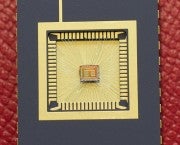IBM has created prototype chips that could mimic brain-like functionality, which the company said is an "unprecedented" step forward in creating intelligent computers that collect, process, and understand data quickly.

The prototype chips will give mind-like abilities for computers to make decisions by collating and analyzing immense amounts of data, similar to humans gathering and understanding a series of events, said Dharmendra Modha, project leader for IBM Research. The experimental chips, modeled around neural systems, mimic the brain's structure and operation through silicon circuitry and advanced algorithms.
IBM hopes reverse-engineering the brain into a chip could forge computers that are highly parallel, event-driven and passive on power consumption, Modha said. The machines will be a sharp departure from modern computers, which have scaling limitations and require set programming by humans to generate results.
"In today's computers, there are some key fundamental limitations that are projected to come to an end," Modha said. "The ever-increasing clock rates are unsustainable. In contrast, the brain is an ultimate computer."
Like the brain, IBM's prototype chips can dynamically rewire to sense, understand and act on information fed via sight, hearing, taste, smell and touch, or through other sources such as weather and water-supply monitors. The chips will help discover patterns based on probabilities and associations, all while rivaling the brain's compact size and low power usage, Modha said.

"We now have the seeds of a new architecture that can allow us to mine the boundary between the physical and the digital world in an ever more efficient way," Modha said.
The chips could help manage water supplies through real-time data analysis and pattern recognition, Modha said. Computers could generate tsunami warnings through a network of sensors monitoring temperature, pressure, wave height and ocean tide. The chips' cognitive features could help grocers identify bad produce and give smartphones features to better interact with the environment.
IBM and its research partners have already generated some results from the project, such as walking through a maze, playing a game of Pong, or recognizing patterns in data. The researchers are gunning for better results that include image recognition in videos.
IBM has made two prototype chips using
the 45-nanometer manufacturing process. Based on traditional circuitry, the chips are organized in a way to recreate the phenomena between spiking neurons and synapses in brains with the help of integrated memory, computation and communication features. The chips use the same basic elements of transistors in microprocessors today, but are wired differently, Modha said.
The company has built individual "digital neurons" in the chips as low-power processing units, and synapses to establish connections between neurons. The neurons and synapses are organized in cross-bar arrays and are supported by a communications infrastructure for neurons to exchange data in real time. The neurons remember recent activities, while the synapses remember the neurons they are associated with.
The chips contain 256 "digital neurons" running at slow speeds of 10MHz that are constantly blasting information to each other. One core contains 262,144 programmable synapses, while the other core contains 65,536 "learning" synapses. Like in the brain, the synapse establishes connections between digital neurons, and the more often a signal is sent to a synapse, the stronger the synapse gets.
It is possible to equip modern computers with many low-power processing units for such functionality, Modha said. But the buses separating the processing units could be a bottleneck, and as the data piles up, the cores need to operate at faster clock rates.
"Functionality of the chip can be simulated on today's computers. But since today's computers are unlike the brain, you pay ... magnitudes more on power and volume," Modha said.
The prototype chips incorporate a simplified model of the human brain, which has billions of neurons and trillions of synapses. IBM said the chips are the foundation of what could eventually be a "mammalian-scale system," which will include 10 billion neurons and 100 trillion synapses with the power consumption and size that rivals the human brain. Modha could not provide a time frame within which the computer would be made, but said results from the current research could change the way computers are built.
Brains are also able to think "outside the box" to conduct activity, so how close do the chips actually come in terms of intelligence? Modha said the chip is intended to mimic brain-like functionality, and that digital neurons will be able to pull a wider range of stimuli and environments and respond more robustly to a wide range of situations.
IBM developed the chips along with partners as part of a multiyear research initiative called Systems of Neuromorphic Adaptive Plastic Scalable Electronics (SyNAPSE), which focuses on cognitive computing. IBM and its partners are bringing together the neuroscience, nanotechnology and supercomputing fields to create the new computing platform.
IBM's research partners include Columbia University; Cornell University; University of California, Merced; and University of Wisconsin, Madison. IBM and its university partners also announced on Thursday that they received US$21 million in additional funding for the project from DARPA (Defense Advanced Research Projects Agency), an agency that is part of the U.S. Department of Defense






